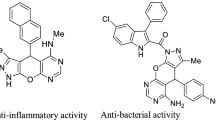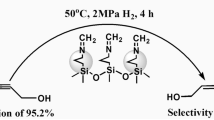Abstract
The immobilization of homogeneous catalytic material over suitable heterogeneous support is amongst the recent strategies to minimize the shortcomings and unite the merits of homogeneous and heterogeneous catalysts. However, the physisorption-based immobilization does not serve the purpose because of its temperature as well as solvent dependent highly reversible nature. In the present work, a new catalytic material silica bonded bis(hydrogensulphato)benzene (SiO2-BHSB) was developed through the chemisorption of benzene-1,3-disulfonic acid as an active catalytic material over the surface of micro-sized silica. The synthesis, structure, purity, thermal stability and acid strength of the newly synthesized catalytic material were confirmed by appropriate analytical techniques such as solid-state CP-MAS 13C-NMR, CP-MAS 29Si-NMR, FT-IR, EDX, TGA, DSC and volumetric studies. An efficient and environmentally benign catalytic protocol for the synthesis of highly substituted 4H-pyran scaffolds was developed, in which a small amount of SiO2-BHSB (3 mol%) was observed sufficient to promote a tandem reaction between alkyl acetoacetate, malononitrile and structurally diverse aldehydes to offer good to excellent yields of 4H-pyran derivatives in aqueous based solvent. Structures of the synthesized 4H-pyran derivatives were confirmed by suitable characterization techniques. The catalytic material was observed to have enough catalytic potential to exhibit sustained catalytic activity even after five cycles of its reuse. Features such as presence of two -SO3H groups, strong acidic character, organo–inorganic hybrid nature, highly stable and chemically inert silica base, high heat of adsorption, large surface area and effective pore volume make SiO2-BHSB a versatile and convenient catalytic material. Herein described catalytic protocol stood better in terms of convenient recovery and reuse of catalyst, waste minimization, environment safety, aqueous based solvent, normal energy conditions and operational simplicity than majority of the cited protocols.
Graphical Abstract









Similar content being viewed by others
Availability of Data and Materials
All the data generated and discussed in this article are included in the manuscript and supporting information of the article only, no additional data sheet is linked.
References
Gawande MB, Branco PS, Varma RS (2013) Nano-magnetite (Fe3O4) as a support for recyclable catalysts in the development of sustainable methodologies. Chem Soc Rev 42(8):3371. https://doi.org/10.1039/c3cs35480f
Faruque MO, Razzak SA, Hossain MM (2020) Application of heterogeneous catalysts for biodiesel production from microalgal oil—a review. Catalysts 10(9):1025. https://doi.org/10.3390/catal10091025
Kasinathan P, Lang C, Radhakrishnan S, Schnee J, D’Haese C, Breynaert E, Fernandes AE (2019) Click’ silica-supported sulfonic acid catalysts with variable acid strength and surface polarity. Chem Eur J 25(27):6753–6762. https://doi.org/10.1002/chem.201806186
Busca G, Gervasini A (2000) Solid acids, surface acidity and heterogeneous acid catalysis. Adv Catal 67:1–90. https://doi.org/10.1016/bs.acat.2020.09.003
Wilson K, Clark JH (2000) Solid acids and their use as environmentally friendly catalysts in organic synthesis. Pure Appl Chem 72(7):1313–1319. https://doi.org/10.1351/pac200072071313
Liu F, Wang L, Sun Q, Zhu L, Meng X, Xiao FS (2012) Transesterification catalyzed by ionic liquids on superhydrophobic mesoporous polymers: heterogeneous catalysts that are faster than homogeneous catalysts. J Am Chem Soc 134(41):16948–16950. https://doi.org/10.1021/ja307455w
Gupta P, Paul S (2014) Solid acids: green alternatives for acid catalysis. Catal Today 236:153–170. https://doi.org/10.1016/j.cattod.2014.04.010
Clark JH, Rhodes CN (2000) Clean synthesis using porous inorganic solid catalysts and supported reagents. The Royal Society of Chemistry, Cambridge
Lee DW, Jin MH, Park JH, Lee YJ, Choi YC, Chan Park J, Chun DH (2018) Alcohol and water free synthesis of mesoporous silica using deep eutectic solvent as a template and solvent and its application as a catalyst support for formic acid dehydrogenation. ACS Sustain Chem Eng 6(9):12241–12250. https://doi.org/10.1021/acssuschemeng.8b02606
Li CJ (2005) Organic reactions in aqueous media with a focus on carbon−carbon bond formations: a decade update. Chem Rev 105(8):3095–3166. https://doi.org/10.1021/cr030009u
Hailes HC (2007) Reaction solvent selection: the potential of water as a solvent for organic transformations. Org Process Res Dev 11(1):114–120. https://doi.org/10.1021/op060157x
Li CJ, Chan TH (1997) Organic reactions in aqueous media. Wiley, New York
Singh SK, Savoy AW (2019) Ionic liquids synthesis and applications: an overview. J Mol Liq 297:112038. https://doi.org/10.1016/j.molliq.2019.112038
Su W, Zhang H, Xing Y, Li X, Wang J, Cai CA (2021) Bibliometric analysis and review of supercritical fluids for the synthesis of nanomaterials. Nanomaterials 11:336. https://doi.org/10.3390/nano11020336
Li CJ, Chen L (2006) Organic chemistry in water. Chem Soc Rev 35(1):68–82. https://doi.org/10.1039/b507207g
Insuasty D, Castillo J, Becerra D, Rojas H, Abonia R (2020) Synthesis of biologically active molecules through multicomponent reactions. Molecules 25(3):505. https://doi.org/10.3390/molecules25030505
Hatakeyama S, Ochi N, Numata H, Takano S (1988) A new route to substituted 3-methoxycarbonyldihydropyrans; enantioselective synthesis of (–)-methyl elenolate. J Chem Soc Chem Commun 17:1202–1204. https://doi.org/10.1039/c39880001202
Raj V, Lee J (2020) 2H/4H-Chromenes - a versatile biologically attractive scaffold. Front Chem 8:623. https://doi.org/10.3389/fchem.2020.00623
Morgan LR, Jursic BS, Hooper CL, Neumann DM, Thangaraj K, LeBlanc B (2002) Anticancer activity for 4,4′-Dihydroxybenzophenone-2,4-dinitrophenylhydrazone (A-007) analogues and Their abilities to interact with lymphoendothelial cell surface markers. Bioorg Med Chem Lett 12(23):3407–3411. https://doi.org/10.1016/s0960-894x(02)00725-4
Saundane AR, Vijaykumar K, Vaijinath AV (2013) Synthesis of novel 2-amino-4-(5′-substituted-2′-phenyl-1H-indol-3′-yl)-6-aryl-4H-pyran-3-carbonitrile derivatives as antimicrobial and antioxidant agents. Bioorg Med Chem Lett 23(7):1978–1984. https://doi.org/10.1016/j.bmcl.2013.02.036
Wu JYC, Fong WF, Zhang JX, Leung CH, Kwong HL, Yang MS, Cheung HY (2003) Reversal of multidrug resistance in cancer cells by pyranocoumarins isolated from Radix Peucedani. Eur J Pharm 473(1):9–17. https://doi.org/10.1016/s0014-2999(03)01946-0
Upadhyay KD, Dodia NM, Khunt RC, Chaniara RS, Shah AK (2018) Synthesis and biological screening of pyrano[3,2-c]quinoline analogues as anti-inflammatory and anticancer agents. ACS Med Chem Lett 9(3):283–288. https://doi.org/10.1021/acsmedchemlett.7b0054
Rueping M, Sugiono E, Merino E (2008) Asymmetric organocatalysis: an efficient enantioselective access to benzopyrans and chromenes. Chem Eur J 14(21):6329–6332. https://doi.org/10.1002/chem.200800836
Venkatesham A, Rao RS, Nagaiah K, Yadav JS, Roopa Jones G, Basha SJ, Addlagatta A (2012) Synthesis of new chromeno-annulated cis-fused pyrano[3,4-c]pyran derivatives via domino Knoevenagel–hetero-Diels–Alder reactions and their biological evaluation towards antiproliferative activity. Med Chem Commun 3(6):652. https://doi.org/10.1039/c2md20023f
Mohamed R, Yaseen AMME, Ashraf AA, Mohamed AA, Hazem MF, Alan BB, Jacey RP, Kevin ND, Tamer SK (2021) Development of 2′-aminospiro [pyrano[3,2–c]quinoline]-3′-carbonitrile derivatives as non-ATP competitive Src kinase inhibitors that suppress breast cancer cell migration and proliferation. Bioorg Chem 116:105344. https://doi.org/10.1016/j.bioorg.2021.105344
Heydari Z, Mohammadi-Khanaposhtani M, Imanparast S, Faramarzi MA, Mahdavi M, Ranjbar PR, Larijani B (2019) Pyrano[3,2-c]quinoline derivatives as new class of α-glucosidase inhibitors to treat type 2 diabetes: synthesis, in vitro biological evaluation and kinetic study. Med Chem 15(1):8–16. https://doi.org/10.2174/1573406414666180528110104
Armesto D, Horspool WM, Martin N, Ramos A, Seoane C (1989) Synthesis of cyclobutenes by the novel photochemical ring contraction of 4-substituted 2-amino-3,5-dicyano-6-phenyl-4H-pyrans. J Org Chem 54(13):3069–3072. https://doi.org/10.1021/jo00274a021
Hafez EAA, Abdul Galil FM, Sherif SM, Elnagdi MH (1986) Nitriles in heterocyclic synthesis. A novel synthesis of spiropyran-4-ylindolidene derivatives. J Heterocycl Chem 23(5):1375–1378. https://doi.org/10.1002/jhet.5570230523
Kaur M, Priya A, Sharma A, Singh A, Banerjee B (2022) Glycine and its derivatives catalyzed one-pot multicomponent synthesis of bioactive heterocycles. Synth Commun 52(16):1635–1656. https://doi.org/10.1080/00397911.2022.2090262
Brahmachari G, Banerjee B (2013) Facile and one-pot access to diverse and densely functionalized 2-amino-3-cyano-4H-pyrans and pyran-annulated heterocyclic scaffolds via an eco-friendly multicomponent reaction at room temperature using urea as a novel organo-catalyst. ACS Sustain Chem Eng 2(3):411–422. https://doi.org/10.1021/sc400312n
Mansoor SS, Logaiya K, Aswin K, Sudhan PN (2015) An appropriate one-pot synthesis of 3,4-dihydropyrano[c]chromenes and 6-amino-5-cyano-4-aryl-2-methyl-4H-pyrans with thiourea dioxide as an efficient, reusable organic catalyst in aqueous medium. J Taibah Univ Sci 9(2):213–226. https://doi.org/10.1016/j.jtusci.2014.09.008
Waghmare AS, Pandit SS, Suryawanshi DM (2018) DABCO catalyzed green and efficient synthesis of 2-amino-4H-pyrans and their biological evaluation as antimicrobial and anticancer agents. Comb Chem High Throughput Screen 21(4):254–261. https://doi.org/10.2174/1386207321666180315095422
Lu GP, Cai C (2010) A facile, one-pot, green synthesis of polysubstituted 4H-pyrans via piperidine-catalyzed three-component condensation in aqueous medium. J Heterocycl Chem 48(1):124–128. https://doi.org/10.1002/jhet.528
Rastgoo YM, Goli-Jolodar O, Shirini F (2018) Piperazine: An excellent catalyst for the synthesis of 2-amino-3-cyano-4H-pyrans derivatives in aqueous medium. Bioorg Chem 81:326–333. https://doi.org/10.1016/j.bioorg.2018.08.026
Ramadoss H, Kiyani H, Mansoor S (2017) Triphenylphosphine catalysed facile multicomponent synthesis of 2-amino-3-cyano-6-methyl-4-aryl-4H-pyrans. Iran J Chem Chem Eng 36(1):19–26. https://doi.org/10.30492/ijcce.2017.25186
Xu X, Shi W, Zhou Y, Wang Y, Zhang M, Song L, Deng H (2015) Convenient one-pot synthesis of monofluorinated functionalized 4-H-pyran derivatives via multi-component reactions. J Fluor Chem 176:127–133. https://doi.org/10.1016/j.jfluchem.2015.05.00
Heravi MM, Beheshtiha YS, Pirnia Z, Sadjadi S, Adibi M (2009) One-pot, three-component synthesis of 4H-pyrans using Cu(II)oxymetasilicate. Synth Commun 39(20):3663–3667. https://doi.org/10.1080/00397910902796102
Dekamin MG, Peyman SZ, Karimi Z, Javanshir S, Naimi-Jamal MR, Barikani M (2016) Sodium alginate: an efficient biopolymeric catalyst for green synthesis of 2-amino-4H-pyran derivatives. Int J Biol Macromol 87:172–179. https://doi.org/10.1016/j.ijbiomac.2016.01.08
Pandharpatte MS, Mulani KB, Mohammed NNG (2012) Microwave promoted, sodium acetate catalyzed one pot synthesis of poly functionalized 4h-pyrans. J Chinese Chem Soc 59(5):645–649. https://doi.org/10.1002/jccs.201100304
De Souza SM, da Silva-Filho LC (2016) NbCl5-promoted the synthesis of 4H-pyrans through multicomponent reaction. Tetrahedron Lett 57(46):5050–5052. https://doi.org/10.1016/j.tetlet.2016.10.008
Valizadeha H, Azimi AA (2011) ZnO/MgO Containing ZnO nanoparticles as a highly effective heterogeneous base catalyst for the synthesis of 4H-pyrans and coumarins in [bmim]BF4. J Iran Chem Soc 8(1):123–130
Khoobi M, Ma’mani L, Rezazadeh F, Zareie Z, Foroumadi A, Ramazani A, Shafiee A (2012) One-pot synthesis of 4H-benzo[b]pyrans and dihydropyrano[c]chromenes using inorganic–organic hybrid magnetic nanocatalyst in water. J Mol Catal A 359:74–80. https://doi.org/10.1016/j.molcata.2012.03.023
Mohammad RPH, Parinaz A, Esmail V (2022) Green synthesis and antibacterial, antifungal activities of 4H-pyran, tetrahydro-4H-chromenes and spiro2-oxindole derivatives by highly efficient Fe3O4@SiO2@NH2@Pd(OCOCH3)2 nanocatalyst. J Mol Struct 1249:31534. https://doi.org/10.1016/j.molstruc.2021.131534
Yadav P, Kakati P, Singh P, Awasthi SK (2021) Application of sulfonic acid fabricated cobalt ferrite nanoparticles as effective magnetic nanocatalyst for green and facile synthesis of benzimidazoles. Appl Catal A 612:118005. https://doi.org/10.1016/j.apcata.2021.118005
Teimuri-Mofrad R, Gholamhosseini-Nazari M, Payami E, Esmati S (2017) Ferrocene-tagged ionic liquid stabilized on silica-coated magnetic nanoparticles: efficient catalyst for the synthesis of 2-amino-3-cyano-4H-pyran derivatives under solvent-free conditions. Appl Organomet Chem 32(1):e3955, 1–16. https://doi.org/10.1002/aoc.3955
Jamshidi A, Maleki B, Zonoz FM, Tayebee R (2018) HPA-dendrimer functionalized magnetic nanoparticles (Fe3O4@D-NH2-HPA) as a novel inorganic-organic hybrid and recyclable catalyst for the one-pot synthesis of highly substituted pyran derivatives. Mater Chem Phys 209:46–59. https://doi.org/10.1016/j.matchemphys.2018.01
Gangu KK, Maddila S, Mukkamala SB, Jonnalagadda SB (2017) Synthesis, structure, and properties of new Mg(II)-metal–organic framework and its prowess as catalyst in the production of 4H-pyrans. Ind Eng Chem Res 56(11):2917–2924. https://doi.org/10.1021/acs.iecr.6b04795
Zaharani L, Khaligh NG, Mihankhah T, Johan MR (2020) Application of nitrogen-rich porous organic polymer for the solid-phase synthesis of 2-amino-4H-benzo[b]pyran scaffolds using ball milling process. Mol Divers 25(1):323–332. https://doi.org/10.1007/s11030-020-10092-4
Lü CW, Wang JJ, Li F, An YuSJ, Y, (2018) Efficient synthesis of 2-amino-3-cyano-4H-pyran derivatives via a non-catalytic one-pot three-component reaction. Res Chem Intermed 44:1035–1043. https://doi.org/10.1007/s11164-017-3151-9
Mehravar M, Mirjalili BBF, Babaei E, Bamoniri A (2021) Nano-SiO2/DBN: an efficacious and reusable catalyst for one-pot synthesis of tetrahydrobenzo[b]pyran derivatives. BMC Chem 15(1):34. https://doi.org/10.1186/s13065-021-00760-3
Saneinezhad S, Mohammadi L, Zadsirjan V, Bamoharram FF, Heravi MM (2020) Silver nanoparticles-decorated Preyssler functionalized cellulose biocomposite as a novel and efficient catalyst for the synthesis of 2-amino-4H-pyrans and spirochromenes. Sci Rep 10:14540. https://doi.org/10.1038/s41598-020-70738-z
Niknam K, Borazjani N, Rashidian R, Jamali A (2013) Silica-bonded N-propylpiperazine sodium n-propionate as recyclable catalyst for synthesis of 4H-pyran derivatives. Chin J Catal 34(12):2245–2254. https://doi.org/10.1016/s1872-2067(12)60693-7
Kharbangar I, Rohman MR, Mecadon H, Myrboh B (2012) KF-Al2O3 as an efficient and recyclable basic catalyst for the synthesis of 4H-pyran-3-carboxylates and 5-Acetyl-4-pyrans. Int J Org Chem 02(03):282–286. https://doi.org/10.4236/ijoc.2012.23038
Hajipour AR, Khorsandi Z (2017) Application of immobilized proline on CNTs and proline ionic liquid as novel organocatalysts in the synthesis of 2-amino-4H -pyran derivatives: a comparative study between their catalytic activities. Chem Sel 2(28):8976–8982. https://doi.org/10.1002/slct.201700847
Patil P, Kadam S, Patil D, More P (2022) An eco-friendly innovative halide and metal-free basic ionic liquid catalyzed synthesis of tetrahydrobenzo [b] pyran derivatives in aqueous media: a sustainable protocol. J Mol Liq 345:117867. https://doi.org/10.1016/j.molliq.2021.117867
Khurana JM, Chaudhary A (2012) Efficient and green synthesis of 4H-pyrans and 4H-pyrano[2,3-c] pyrazoles catalyzed by task-specific ionic liquid [bmim]OH- under solvent-free conditions. Green Chem Lett Rev 5(4):633–638. https://doi.org/10.1080/17518253.2012.691183
Peng Y, Song G, Huang F (2005) Tetramethylguanidine-[bmim][BF4]. an efficient and recyclable catalytic system for one-pot synthesis of 4H-pyrans. Monatsh Chem 136(5):727–731. https://doi.org/10.1007/s00706-004-0270-y
Kadam KR (2020) An expedient carbon–sulfur bond formation explored through the cellulose sulfonic acid (CSA) catalyzed dithioacetal protection of carbonyl compounds. J Sulfur Chem 41(5):530–541. https://doi.org/10.1080/17415993.2020.1775835
Kadam KR, Kamble NR, Kamble VT (2020) NbCl5-AgClO4 as an effective, synergetic catalytic system for the synthesis of fully substituted pyrazoles. Rasayan J Chem 13(2):854–859. https://doi.org/10.31788/RJC.2020.1325728
Kamble VT, Kadam KR, Waghmare AS, Murade VD (2020) Synthesis of silica chemisorbed bis(hydrogensulphato)benzene (SiO2–BHSB) as a new hybrid material and it’s utility as an efficient, recyclable catalyst for the green synthesis of bis(indolyl)methanes. Sustain Chem Pharm 18:100314. https://doi.org/10.1016/j.scp.2020.100314
Kamble VT, Waghmare AS, Murade VD, Kadam KR (2021) Silica chemisorbed bis(hydrogensulphato)benzene (SiO2-BHSB) as a new, efficient, and recyclable catalyst for the synthesis of 5-oxopyrono[3,2-c]chromene scaffolds in water-based solvent. Phosphorus Sulfur Silicon Relat Elem 196:1038–1048. https://doi.org/10.1080/10426507.2021.1986503
Kadam KR, Pandhare GR, Waghmare AS, Murade VD, Kamble NR, Kamble VT (2023) Silica chemisorbed bis(hydrogensulphato)benzene (SiO2-BHSB) as a new, environmentally benign and recyclable catalyst for an efficient synthesis of biscoumarin scaffolds in water-based solvent. Polycycl Aromat Compd 43(1):647–664. https://doi.org/10.1080/10406638.2021.2019801
Gorlov YI, Nesterenko AM, Chuiko AA (1996) The chemisorption of acid chlorides on the silica surface. Colloids Surf A 106(2–3):83–88. https://doi.org/10.1016/0927-7757(95)03283-5
Zolfigol MA, Madrakian T, Ghaemi E, Afkhami A, Azizian S, Afshar S (2002) Synthesis of morpholinated and 8-hydroxyquinolinated silica gel and their application to water softening. Green Chem 4(6):611–614. https://doi.org/10.1039/b208526g
Acknowledgements
We offer this article as our deep sense of homage to our recently departed, highly respected late Professor Dr. V. T. Kamble Sir, (Head, Department of Chemistry, Government Institute of Science, Nagpur, Maharashtra, India). His everlasting blessings and support to our research group will be remembered forever.
Funding
The work was not supported by any funding agency.
Author information
Authors and Affiliations
Contributions
Authors have contributed their share in bringing this work in its present form. All the authors have read the manuscript thoroughly and approved it for submission. Details of author’s contributions is as bellow. Conceptualization and coordination: DSW and KRK; experimental: KRK, SNS, and ASW; materials and resources: GRP, and VDM; characterization and analysis: ASW, and NRK; writing and communication: DSW and KRK.
Corresponding authors
Ethics declarations
Conflict of interest
Authors altogether have declared no conflict of interest, neither financial nor personal.
Ethical Approval
This article does not contain any study on animal or human being.
Additional information
Publisher's Note
Springer Nature remains neutral with regard to jurisdictional claims in published maps and institutional affiliations.
Supplementary Information
Below is the link to the electronic supplementary material.
Rights and permissions
Springer Nature or its licensor (e.g. a society or other partner) holds exclusive rights to this article under a publishing agreement with the author(s) or other rightsholder(s); author self-archiving of the accepted manuscript version of this article is solely governed by the terms of such publishing agreement and applicable law.
About this article
Cite this article
Shringare, S.N., Kadam, K.R., Pandhare, G.R. et al. Heterogenization of Homogeneous Catalyst: An Improved Strategy for an Efficient Synthesis of Highly Substituted 4H-Pyran Scaffolds in Aqueous Based Media. Catal Lett 154, 1993–2007 (2024). https://doi.org/10.1007/s10562-023-04455-3
Received:
Accepted:
Published:
Issue Date:
DOI: https://doi.org/10.1007/s10562-023-04455-3




